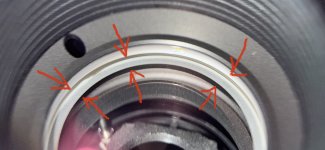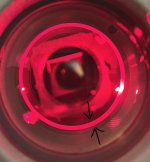kimmik
Well-known member

This has probably crossed many people's mind as well, why would a premium maker of optics seemingly suffer such a basic flaw. All it takes, is blackening of the optical edges, and tightened baffles to be practically glare-free. Leica does this to perfection as part of their signature look, contrasty with saturated colour reproduction.
Studying the Noctivid and EL internals with a torch and laser, side by side, there are some critical clues on why Swarovski differs glare resistance.
Noctivid - All elements and prism sides are blacked to the maximum. There is only faint non-image-forming-light around the exit pupil, allowing exceptional contrast right till the moment the sun enters the FOV. One could consider this ideal.
EL - The clue is found by studying the sources of glare, as you bring a point light source from 90 degrees above, gradually into the FOV.
90degrees - the objective recess stops all glare
60degrees - faint ring of light arises from the objective element edges
30degrees - brighter ring of light arises from the focusing element edges
15degrees - even brighter reflections arise from the first prism element sides
5degrees - this last reflection is very interesting, it is the second prism element sides, and one would expect it to be as bright as the first prism element's sides, but they are distinctly different. The second prism has sides that are far darker than the first, and comparing side by side with the Leica, they look of similar reflectivity, while the first prism sides are distinctly more reflective than Leica.
So clearly Swarovski has the knowhow to blacken prism sides like Leica, but chose to do so only on the second prism element. The first prism element is blackened with a more greyish paint instead, which I conclude is deliberate by design, for the very purpose of inducing glare when light source is within about 15degrees of the visual axis.
The stepwise glare progression, is 1. a reasonable safety mechanism to warn of impending sun-in-view, 2. may also give a global sensation of brightness, when looking in the direction of bright light. Whether this impairs or improves detail in shadows, I will make further tests. It doesn't affect image highlights of course.
Looking next into the SLC 56, another clue can be seen, that the focusing element has not only non-blackened ground glass edges, but ground glass extended onto the optical surface. If this is not deliberately trying to induce glare, I dont know what it could be for!

Studying the Noctivid and EL internals with a torch and laser, side by side, there are some critical clues on why Swarovski differs glare resistance.
Noctivid - All elements and prism sides are blacked to the maximum. There is only faint non-image-forming-light around the exit pupil, allowing exceptional contrast right till the moment the sun enters the FOV. One could consider this ideal.
EL - The clue is found by studying the sources of glare, as you bring a point light source from 90 degrees above, gradually into the FOV.
90degrees - the objective recess stops all glare
60degrees - faint ring of light arises from the objective element edges
30degrees - brighter ring of light arises from the focusing element edges
15degrees - even brighter reflections arise from the first prism element sides
5degrees - this last reflection is very interesting, it is the second prism element sides, and one would expect it to be as bright as the first prism element's sides, but they are distinctly different. The second prism has sides that are far darker than the first, and comparing side by side with the Leica, they look of similar reflectivity, while the first prism sides are distinctly more reflective than Leica.
So clearly Swarovski has the knowhow to blacken prism sides like Leica, but chose to do so only on the second prism element. The first prism element is blackened with a more greyish paint instead, which I conclude is deliberate by design, for the very purpose of inducing glare when light source is within about 15degrees of the visual axis.
The stepwise glare progression, is 1. a reasonable safety mechanism to warn of impending sun-in-view, 2. may also give a global sensation of brightness, when looking in the direction of bright light. Whether this impairs or improves detail in shadows, I will make further tests. It doesn't affect image highlights of course.
Looking next into the SLC 56, another clue can be seen, that the focusing element has not only non-blackened ground glass edges, but ground glass extended onto the optical surface. If this is not deliberately trying to induce glare, I dont know what it could be for!








